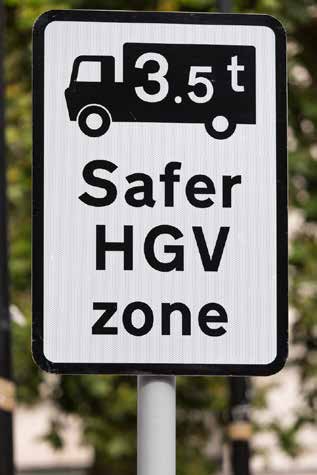Primer for Improved Urban Freight Mobility and Delivery
|
||
Key Accomplishments
|
In 2015, London began enforcing regulations that prohibit lorries (i.e., trucks and other heavy goods vehicles) that lack certain safety equipment from driving on London's roads. The regulations are particularly geared towards construction vehicles, which have been involved in a disproportionate number of fatal collisions involving cyclists and pedestrians. According to TfL, heavy goods vehicles accounted for less than 4 percent of the total miles driven in London, but they were involved in 78 percent of cyclist fatalities and 20 percent of pedestrian fatalities in 2015. The Safer Lorry Scheme, as the regulatory program is called, is one component of a wider set of initiatives to reduce the number of people killed or seriously injured on London's roads.
Development and implementation of the Safer Lorry Scheme was led by Transport for London (TfL), which is an integrated transport authority that manages most of London's main roads and public transport network. At the request of London's mayor, TfL conducted a feasibility study to consider various ways of improving truck safety in London. The study confirmed that certain heavy goods vehicles were permitted to operate without certain safety equipment such as side guards and some types of mirrors. The study concluded that such equipment would have made a substantial difference in the outcomes of recent collisions between cyclists and trucks. The study found that construction vehicles were particularly dangerous, because although they are designed for heavy-duty functioning on work sites and not on-the-road driving, in reality they spend more than 90 percent of the time on the road with other road users.
These findings led TfL to proceed with implementing the Safer Lorry Scheme. It took approximately 18 months from the conclusion of the feasibility study in 2014 until regulations went into effect in September 2015. The scheme operates across London, 24 hours a day, seven days a week, covering most of greater London. The area covered by the Safer Lorry Scheme is the same as for the city's pre-existing Low Emission Zone. Owners of vehicles over 3.5 metric tons that are currently exempt from national requirements for basic safety equipment are now required to:

Signs like this one mark the boundary of London's Safer Heavy Goods Vehicle (HGV) Zone. Source: TfL.
To build consensus and ensure program success, TfL worked with a variety of stakeholder groups through its Freight Forum, a stakeholder group that was established during the 2012 Olympics to ensure continuity of freight operations during the games. The Forum is made up of the London boroughs (which manage the majority of roads in London), London Councils, truck operators, rail freight groups, and other industry stakeholders. The Safer Lorry Scheme was also the subject of a full public, statutory consultation.
Enforcement is an important component of the Safer Lorry Scheme's success. The scheme is enforced by the Metropolitan Police Service, City of London Police, and the Driver and Vehicle Standards Agency. Drivers found to be operating a non-compliant vehicle may be issued a fine of £50 (about $66), and the offense also carries a potential fine of £1,000 (about $1,300) at Magistrate's court. The Traffic Commissioner, who has the power to modify or suspend operator licenses, is also notified of companies operating vehicles in breach of the scheme.
The success of the Safer Lorry Scheme has prompted TfL to engage in other efforts to reduce road dangers for vulnerable road users (i.e., pedestrians, cyclists, and motorcyclists). For example, TfL is working with vehicle manufacturers, fleet operators, and others to change the overall designs of heavy goods vehicles to increase drivers' direct vision. According to Tfl, its research shows that drivers react more quickly when they can see cyclists and pedestrians directly rather than by use of mirrors or other equipment. The agency has also developed a Direct Vision Standard, which is a star rating system for heavy goods vehicles based on how much a driver can see of the area of greatest risk to vulnerable road users. TfL is also continuing to work with the construction industry to encourage behavior changes that reduce the road dangers associated with construction logistics.
Tim Ward, Freight and Fleet Communications and Engagement Manager, Transport for London, +44 020 3054 7209, timward@tfl.gov.uk
|
United States Department of Transportation - Federal Highway Administration |
||